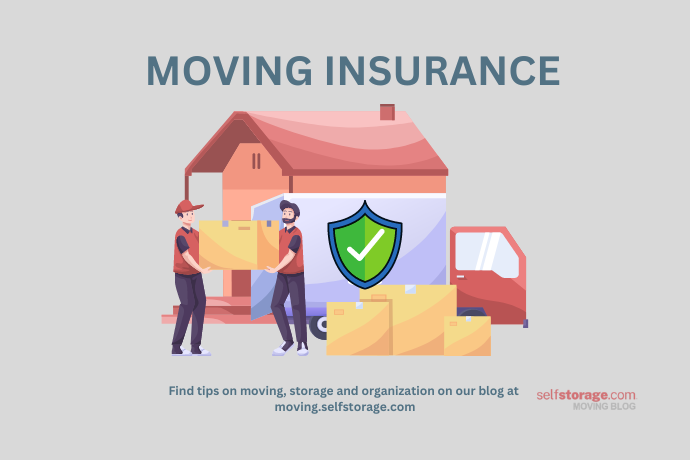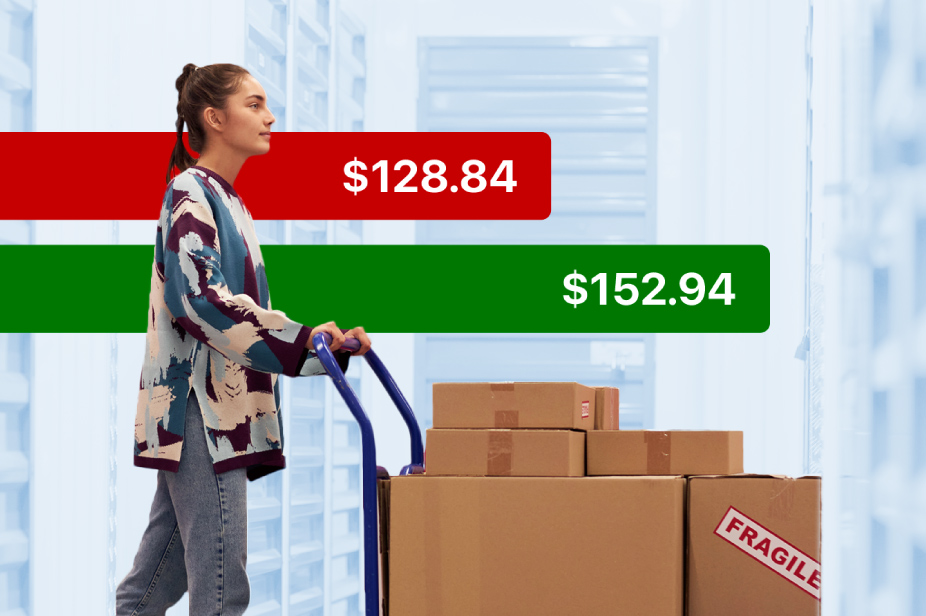What’s covered in this article – click on a link to learn more:
- Part One: Understanding Moving Insurance Coverage
- Part Two: How to Choose Moving Insurance
- Part Three: Reasons Why Moving Insurance is Important
When Lisa Schockemoehl saw the moving truck pull up with her things, her heart sank and she started to cry. “My brand new mattress was tied to the back of the truck and had come all the way to Minnesota from Atlanta in the pouring rain, it was ruined,” she said. And the items that were supposed to be safely tucked inside the truck were in even worse shape. Most of her items had either been stolen, damaged or were in such poor condition they were unusable. While Schockemoehl was dealing with the fallout from being the victim of a common moving scam, she couldn’t help but wonder if having adequate moving insurance would have better protected her.
Moving is a significant life event that often comes with excitement and anticipation. However, amidst the chaos of packing boxes and coordinating logistics, the risk of accidents, damages, and loss to your belongings is a looming concern. And in the hustle and bustle of moving preparations, the significance of securing your belongings often takes a backseat.
In this blog post, we’re diving into the world of moving insurance, including the different types, how it works, the pivotal role it plays in safeguarding your possessions and shielding you from financial risks, as well as why it’s an indispensable aspect of any moving plan.
Part One: Understanding Moving Insurance and the Different Options Available
Moving insurance isn’t just a formality; it’s your shield against the uncertainties that accompany a move. Moving can be a stressful and unpredictable experience, having the right insurance in place can help mitigate the financial aspect of potential losses.
Moving insurance is a type of insurance coverage that protects your belongings during a move from one location to another. It is designed to provide financial compensation in case your items are lost, damaged, or stolen during the moving process. These are some of the questions that come up when people are looking to understand more about moving insurance.
Is a moving company required to protect my things?
Federal law states that movers going from one state to another must offer two different liability options referred to as valuation coverage: full value protection moving insurance and released value protection (basic coverage).
The Federal Motor Carrier Safety Administration says the regulations only apply when the mover transports your household goods in interstate or foreign commerce (moving between states or internationally). The regulations do not apply when your move takes place within a commercial zone or between two points in the same state.
The FMCSA has a “Your Rights and Responsibilities When You Move” booklet (movers are required to provide a copy when you move) that has more detailed information on the types of coverage.
The main differences between full value protection and released value protection are highlighted below.
| Full Value Protection vs. Released Value Protection, What Are the Differences? | |
| Full Value Protection | Released Value Protection |
| This is the more comprehensive and premium option. With full value protection, the moving company is responsible for the replacement value or repair cost of any lost or damaged items, up to the declared value of your entire shipment. Unless you choose the released value option, your mover will automatically move your belongings under this level of liability. | Released value protection is a basic option provided by moving companies at no additional cost to you. |
| If an item is lost, damaged, or destroyed during the move, the moving company may choose to repair the item, replace it with a similar item, or provide a cash settlement for the current market value of the item. | Under this coverage, the moving company assumes liability for your belongings at a predetermined rate, which is no more than 60 cents per pound per item. This rate is usually much lower than the actual value of your items. For example, if your mover lost or damaged a 50-inch TV weighing 25 pounds, you would only receive $15 (60 cents x 25 pounds). |
| However, keep in mind that there may be specific rules and limitations regarding high-value items, so it’s essential to understand the terms and conditions of the insurance policy. For example, movers are allowed to limit their legal responsibility to loss or damage to items of “extraordinary value” (items valued at more than $100 per pound, such as jewelry, china, or furs). If you specifically list these items on the shipping documents, they are still responsible for the safe delivery. Ask for a written explanation of any limitations before you move. | While released value protection does not cost anything, it may not fully cover the cost of replacing or repairing valuable items. If you choose this option, you must sign a specific statement on the bill of lading or contract agreeing to it. Just remember that you will only be compensated according to the weight of the item, not its actual value. If you do not select released value protection, your shipment will automatically be transported at the full value protection. |
Is valuation the same thing as insurance?
Valuation is not the same thing as insurance. Valuation refers to the amount a moving company is liable for if your items get damaged or lost during a move. Coverage with valuation is usually more limited than third-party insurance.
You may also encounter a scenario where your moving company asks you to place a value on the belongings that will get shipped. The dollar amount you come up with for your items is also considered valuation.
Does my homeowners or renters policy cover my items in transit?
Insurance policies vary from carrier to carrier. You should consult with your insurance agent to be sure but generally speaking homeowners or renters insurance policies do not cover your belongings in a move. If they do provide any coverage it could be limited, leaving you with a scenario where you think your items are covered but it’s only up to a certain amount.
This scenario illustrates the difference between what homeowners insurance covers and where moving insurance comes into play. If you pay to have movers pack your things while they’re still in your home, homeowners insurance would cover any accidental damage. The second your belongings are considered “in transit” with the moving company, a homeowners policy is no longer in play, and moving insurance kicks in.
Can I buy supplemental insurance to better protect my belongings through the moving company?
Moving companies are not authorized to sell insurance so you’ll have to purchase supplemental insurance from a third-party carrier. Important note: this is not valuation coverage governed by Federal law but optional insurance regulated by state law.
For example, if you choose released value protection but are worried about it not covering the true value of your items, third-party insurance could cover the difference. Since released value protection only covers up to 60 cents per pound per item, additional moving insurance coverage could protect the remaining 40 cents per pound per item.
Part Two: How to Choose the Best Moving Insurance Option
Whether you’re relocating locally or across the country, accidents and unforeseen events can happen. How to choose the best moving insurance depends a lot on what you plan to move. Full value protection offered through the moving company is a great choice. If you’re concerned about several high-value (and high dollar amounts) or irreplaceable items getting damaged in transit, you may want to consider third-party insurance. Here are some questions to consider as you weigh your options:
How do I figure the value of my household goods?
You’ll want to try and be as accurate as possible when figuring the value of your household goods because it will be used to factor the cost of replacing any items. Start with this guide to making a moving inventory list.
Is there anything that valuation doesn’t cover?
Typically valuation isn’t going to cover things like natural disasters (earthquakes, fires, floods, etc.) or anything that is beyond the control of their licensed movers. An advantage of purchasing additional moving insurance is that it won’t have liability limits on damaged items and it provides coverage during natural disasters.
How does full value protection work if one of my items is damaged during the move?
If the moving company damages one of your items, they’re liable for the current market value of the item. They will do one of the following as a solution:
- Repair the item
- Replace the item with a similar one
- Offer cash to replace the item (equivalent to the damaged item’s current market value)
Are there any scenarios where full value protection would not cover my items?
Some moving companies will limit the amount of liability they take on to keep the cost of potential claims down. Those scenarios may include:
- You opted not to use full-service movers and failed to have the movers pack your belongings
- You waited too long to report lost or damaged items (up to nine months is the standard window of time for most moving companies)
- You did not declare any extraordinary or high value items in writing
- You included items that cannot be packed in a moving truck without notifying your mover
How much does moving insurance cost?
A question asked a lot is how much is moving insurance? The cost of moving insurance depends on two key factors: one, the value you place on your possessions, and two, the type of coverage you choose. The chart below can help you determine which type of moving insurance is best for you.
| Type of Coverage | What It Covers | Claim Options | Cost | Includes High-Value Items |
| Released value protection | Covers up to 60 cents per pound per item. | No repair or replacement. Does not cover full market value of your items. | Included in your moving contract. | N/A |
| Full value protection | Full coverage for your entire inventory. | Offers repair, replacement, or cash settlement up to item’s full market value. | Expect to pay around 1% of the total estimate of the value of your items. | Does not cover items of high value (over $100 per pound). |
| Third-party moving insurance | Full coverage for your entire inventory. | Offers repair, replacement, or cash settlement up to item’s full market value. | Expect to pay anywhere from 1% to 5% of the total estimate of the value of your items. | Does cover items of high value (exceeding $100 per pound). |
Part Three: Reasons Why Moving Insurance is Important
Moving insurance is crucial for several reasons, as it helps protect your belongings during the inherently risky process of relocation. Here are some key points highlighting the importance of moving insurance:
- Accidents and Damages: The process of moving involves various stages, including packing, loading, transportation, unloading, and unpacking. At any of these stages, accidents can happen. An item gets dropped. A TV gets damaged. A precious heirloom is lost. Moving insurance provides coverage for such incidents, ensuring that the cost of repairing or replacing damaged items is not entirely on the owner.
- Loss Prevention: There is always a risk of items getting lost during a move. Whether it’s due to a mix-up, theft, or other unforeseen circumstances, valuable possessions may go missing. Moving insurance can help mitigate the financial impact of such losses by providing compensation for the lost items.
- Financial Consequences: Without proper insurance coverage, the financial consequences of damaged or lost items would be a significant – and unexpected – expense. Especially since repairing or replacing furniture, electronics, and other belongings can be quite expensive. Having moving insurance in place helps alleviate the financial burden and ensures that you can recover the value of your items without taking a huge hit to your wallet.
- Peace of Mind: Worrying about the safety of your possessions during a move adds to an already stressful time of life. Having a comprehensive moving insurance plan provides peace of mind, allowing you to focus on other aspects of the move without constantly worrying about potential losses or damages.
- Professional Movers’ Liability Limitations: While professional moving companies typically take precautions to handle items with care, their liability for damages may be limited. Having your own moving insurance ensures that you have coverage beyond the basic liability offered by the moving company.
- Unforeseen Circumstances: There are various unforeseen circumstances, such as accidents, natural disasters, or traffic incidents, that could impact the safety of your belongings during transportation. Moving insurance can offer protection against these unexpected events.
- Customized Coverage: Moving insurance can be tailored to suit your specific needs. You can choose coverage based on the value of your belongings and the level of risk you want to mitigate. This customization ensures that you are adequately covered for the unique circumstances of your move.
The question remains, do you need moving insurance?
In the grand tapestry of moving, insurance is not a mere accessory but a proactive strategy to safeguard your belongings and ensure a smooth transition to your new home. Whether you need to purchase supplemental moving insurance depends on how comfortable you are with the valuation a moving company provides.
The bottom line is it’s essential to carefully review the terms and conditions of any insurance policy, whether provided by the moving company or a third-party insurer, to ensure that you understand the extent of coverage and any exclusions that may apply. In this case it usually is better to be safe than sorry.


![Survey: Nearly Half of Movers Take Months To Finish Unpacking [+ 10 Unpacking Tips]](https://moving.selfstorage.com/wp-content/uploads/2025/06/how-to-unpack-after-moving-hero.jpg)




